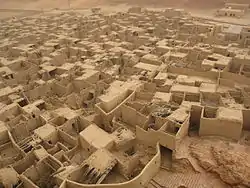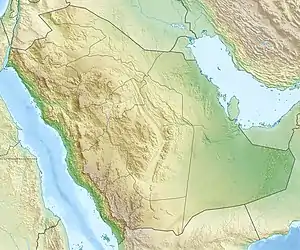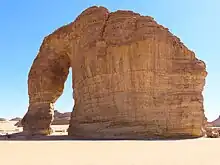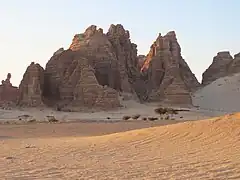Al-'Ula
ٱلْعُلَا | |
|---|---|
 | |
 Al-'Ula | |
| Coordinates: 26°37′N 37°55′E / 26.617°N 37.917°E | |
| Country | |
| Region | Al Madinah |
Al-'Ula[1] (Arabic: ٱلْعُلَا transliterated as al-‘Ulā) is an ancient Arabic oasis city located in Medina Province, Saudi Arabia. (The form AlUla is the proposed (trademarked) communication style by the Royal Commission for AlUla (RCU) as a tool in their tourism development strategy.) Situated in the Hejaz, a region that features prominently in the history of Islam as well as several pre-Islamic Semitic civilizations, al-‘Ulā was a market city on the historic incense route that linked India and the Persian Gulf to the Levant and Europe.
The immediate vicinity contains a unique concentration of precious artifacts, including well-preserved ancient stone inscriptions that illustrate the development of the Arabic language, and a concentration of rock dwellings and tombs that date from the Nabatean and Dedanite periods that coincided with Greco-Roman influence during classical antiquity. Saudi Arabia's first UNESCO World Heritage Site, Hegra (also known as Al-Hijr, or Mada'in Salih), is located 22 km (14 mi) north of the city, in Al-'Ula governorate. Built more than 2,000 years ago by the Nabataeans, Hegra is often compared with its sister city of Petra, in Jordan. Meanwhile, the ancient walled city of Al-'Ula ("Old Town"), situated near the oasis that allowed for its settlement, contains a dense cluster of mud-brick and stone houses.[2] Al-'Ula was also the capital of the ancient Lihyanites (Dedanites).
Today, the city of Al-'Ula is within the Governorate of Al-'Ula (Arabic: مُحَافَظَة ٱلْعُلَا, romanized: Muḥāfathat Al-ʿUlā), one of seven constituent counties of Medina province. The city is located 110 km (68 mi) southwest of Tayma and 300 km (190 mi) north of Medina.[3] The city (municipality) covers 2,391 square kilometres (923 sq mi),[4] and has a population of 5,426.[4] In addition to the ancient old town, a more recent historical city, displaying the settlement patterns of Arabic-Islamic urbanism, remains occupied and is currently experiencing a renaissance. The area is also known for its striking landscape of rocks, canyons, and wadis, and the contrast between these dry surroundings and the lush, palm-filled oases near the city's centre.
Al-'Ula was once a key stop on the Hejaz Railway, linking Damascus to Medina.
History
The Oasis of Al'Ula has had permanent human settlement since 5000 BC, through the Bronze Age.[5] The walled city of Al-'Ula was founded in the 6th century BC, an oasis in the desert valley, with fertile soil and plenty of water. It was located along Incense Road, the network of routes that facilitated the trading of spices, silk and other luxury items through the kingdom of Axum, Arabia, Egypt, and India. Al-'Ula stands on the site of the Biblical city of Dedan but was founded with the ancient north Arabian kingdom of Lihyan, which ruled from the 5th to 2nd century BC.[6] The older history of the oasis has been divided into several phases. The Dedanite kingdom spans the seventh and sixth centuries BC. Dedan is mentioned in the Harran Inscriptions. In these it is told how Nabonidus the king of Babylonia made a military campaign to northern Arabia in 552 BC or somewhat later, conquering Tayma Dedan and Yathrib (Medina).[7] It is thought that around the turn of the fifth century BC the kingdom became hereditary.
.jpg.webp)
The next four hundred years, until around 100 BC, were the time of the Kingdom of Lihyan. The Nabataeans were the lords of the region at least until 106 AD when the Romans conquered their capital Petra. The Nabataeans made Hegra, the modern Mada'in Salih, their second capital. The power centre of the region thus shifted to Hegra some 22 km (14 mi) to the north of Al-'Ula.
Al-Mabiyat some 20 km (12 mi) away near Mughaira became the next commercial centre of the region. It thrived from around 650 until it declined at some time before 1230. In the 13th century the old city of Al-'Ula was built and many stones of the old Dedanite and Lihyanite ruins were reused. Al-'Ula now became the major settlement of the region again until modern times. Between 1901 and 1908 the Ottomans built the Hejaz railway in order to link Damascus to Medina. The railway had main stations in both Mada'in Salih (Hegra) and Al-'Ula, where a line was built through the western part of Al-Khuraybah, some 12 km (7.5 mi) to the north of the old medieval town, which is believed to be the site of the old Dedanite and Lihyanite town that is still standing there despite being in bad shape.
In the 20th century the new town centre was established beside the old town and eventually the people left the old buildings. The last family is said to have left in 1983, whilst the last service in the old mosque was held in 1985.[8] Both the ruins of the medieval town and the site of the Liyhanite settlement now lie within the limits of the modern town.
The most detailed study of the area was made by the French priests Antonin Jaussen and Raphaël Savignac, who visited the area three times, in 1907, 1908 and 1910. They studied the remains at Hegra and Dedan and collected a large number of Lihyanite, Minaean, Thamudic and Nabataean inscriptions. Accordingly, it was their work that came to constitute the basis for all further study and research in the history of the area.[9]
The first European traveller of modern times to describe the town was Charles Doughty in 1876. Charles Huber was in Al-'Ula in 1881–82. He returned in 1883 accompanied by Julius Euting. In 1968 a team of archaeologists from the University of London investigated some fifteen inscriptions.
The vertical sandstone cliffs surrounding the valley provide ample surfaces for rock art, making the governorate one of the richer petroglyph regions in the Kingdom. Ar-Ruzeiqiah is a mountain in the southern part of the governorate, with a large petroglyph panel displaying hundreds of images, including depictions of hunting scenes with humans and a variety of animals. Ibex are the most common species but camels, horses and other species can also be found. Mount Ikma also has a large façade with scenes, strange symbols, and inscriptions.[10]
Timeline
Here is the sequence of historical events and the ancient evidence found in the Al-'Ula governorate:[11]
| History | Evidences |
|---|---|
| Bronze Age |
|
| Ancient North Arabian Kingdoms (DEDAN) |
|
| Nabataean Kingdom (Hegra) |
|
| Roman presence |
|
| Islamic period (QURH, Al-'Ula) |
|
| Ottoman presence |
|
Administration
There are four major municipalities in the Governorate of 'Ula: Al-'Ula: the capital lying to the southwest (population 5,426); Mughīrāʾ (Arabic: مُغِيْرَاء) to the southeast (population 8,952); Abu Raku, to the north (population 2,678); and Al Hajar to the northeast (population 1,707).[4]
Heritage Village
AlUla Heritage Village, also known as Ad-Deerah, is the traditional Arabian village to which people of the oasis moved some eight centuries ago and inhabited until the 20th century. It was built on a higher part of the valley in order to be clear of the floods that can occur during the rainy season. At its maximum expansion the town contained more than 1000 houses, which were built adjacent to one another, thereby forming a wall around the town to defend the population. On the west of the town, at the bottom of the cliff, is the old souq, which has been renovated.[12]
Royal Commission for Al-'Ula
The importance of Al-'Ula as an archaeological and historic site led to the establishment of The Royal Commission for Al-'Ula (RCU) in July 2017, the aim of which is to develop and promote Al-'Ula as an international tourism destination.[13] Moreover, the commission develops the plans for heritage conservation and preservation.[14] The Royal commission for Al-'Ula has taken various development projects in the region, including the five districts planned for Al'Ula by 2030. The five districts include: Al'Ula old town, Dadan, Jabal Ikmah, Nabataeane Horizen, Hegra Historical City, these five districts are part of a larger development plan for Al'Ula that further aims to transform the city into a world-class tourist destination while also preserving its cultural and historical heritage.[15]
Development plan
To promote tourism and gain more attraction, the Royal Commission on Al-'Ula is training 200 young Saudis on an ambitious project where tourists will explore the area's cultural treasures. Recruited from the Al-'Ula region, the 200 young people (all high-school age or in their first year as university students, and split 50-50 between boys and girls) are in Riyadh, Saudi Arabia being trained in hospitality, learning new languages, studying farming and water technology, and researching the cultural, social and natural history of their home region.[16]
Prince Abdul Majeed bin Abdulaziz Airport
The Prince Abdul Majeed bin Abdulaziz International Airport was a crucial part of the development strategy of the Royal Commission for Al-'Ula (RCU), which envisioned making it a global destination for culture and tourism. In March 2021, the airport was approved to receive international flights, along with an increased capacity of receiving 15 commercial flights at a time. The capacity was increased from 100,000 to 400,000 passengers per year.[17][18]
Tourism

The Saudi Arabian government is collaborating with experts from around the world on the Al-'Ula development. In April 2018 it signed a 10-year deal with France that includes provisions for hotels, transport infrastructure and a world-class culture and art museum.[19] Since 2021, RCU has been running SME accelerator in collaboration with AstroLabs to ensure growth of the local tourism ecosystem.[20] With this program, the region has set out on an ambitious mission to welcome 2M tourists and contribute SAR 120Bn to the national GDP by 2030.[21]
A major integrated archaeological survey of Al-'Ula valley and beyond was launched by the commission, charged with protecting and regenerating the north-western region. While a conservation and development plan was established, some of the sites including the World Heritage Site of Mada'in Salih were closed to the public, but have been open since 2020 for visitors.[22]
With the easing of visa process for international travelers, Al Ula attracts more tourists from abroad. Its most popular sites are: Al Ula Old town, Oasis Heritage Trail, Hegra UNESCO Heritage Site, Dadan, Jabal Ikmah, Jabal AlFil (Elephant Rock), Harrarat Viewpoint or Maraya. Travelers from around the world can also enjoy numerous of activities such as stargazing, desert dune bashing, desert campaign, hiking, biking, rock climbing, via ferrata and others.[23]
Accommodation in Al Ula

As the tourism infrastructure is still being developed in Al Ula, finding an affordable accommodation can be a challenge during high season. Tourists have a variety of options ranging from camping sites, holiday homes (apartments or chalets) to luxury resorts. As of 2023 Al'Ula is home to 10 luxury resorts and accommodations available for visitors of the old city, these 10 accommodations include: Our Habitas AlUla, Banyan Tree AlUla, Cloud7 residence, Ashar tented resort, Shaden resort, Gathern accommodations, Sahary Al'Ula resort, Caravan by Habits, 26° North, and the option of self-campaign. Future resorts in Al'Ula include Dar Tantora, the Chedi Hegra, Aman Resorts and Sharaan Resort.[24]
"Winter at Tantora" festival
Winter at Tantora was a traditional celebration to mark the start of the 40 day winter growing season. The name of the festival 'Tantora' is inspired by a sundial located in the old town of Al-'Ula, which has been in use by the locals as a marker for the changing of the seasons.[25] On 20 December 2018, the first "Winter at Tantora" started with a series of different themed weekend events including music, arts, entertainment, and cultural events. The concerts were performed in Maraya Concert Hall, which was newly constructed for this purpose,[26] and whose external walls are covered with mirrors, "Maraya" being the Arab word for "Mirrors".[27] A second edition of Winter at Tantora Festival was held on 19 December 2019, and included performances by Omar Khairat, EBI "Ebrahim hamedi", Andrea Bocelli, Yanni, Enrique Iglesias and Lionel Richie.[28]
On 26 December 2019, Maraya Concert Hall set a Guinness world record for the largest mirrored building in the world, in which it was covered by 9,740 square metres (104,800 sq ft) of mirrored façade.[29]
Azimuth Festival
As part of the "Winter at Tantora" festival, Saudi Arabia hosted a three-day festival of music, art and food. Held between 5–7 March 2020, the Azimuth Festival was an event that brought the east and west together at Al Ula. It marked performances from artists like the Chainsmokers, Jean-Michel Jarre, Tinie Tempah and others.[30] The event took place at the beginning of the COVID-19 pandemic, and so received only little publicity.
Persian Night in Saudi Arabia’s Al-'Ula
From March 6 to March 7 2020, a large concert of Iranian singers was held at the winter celebration of the Kingdom of Saudi Arabia in the city of Al-'Ula. Ebi, Leila Forouhar, Shahram Shabpareh, Shadmehr Aghili, Andy (Andranik Madadian), Arash and Sasy were present at the concert.[31]
Al-'Ula Vision
On 11 February 2019, Saudi Arabia's Crown Prince Mohammed bin Salman launched the Al-'Ula vision which features a resort and nature reserve called Sharaan.[32] The vision also includes the establishment of the Global Fund for the protection and revitalization of the Arabian Leopard.[33]
See also
References
- ↑ "Heritage Sites in Al-'Ula, Saudi Arabia | ExperienceAlUla.com". experiencealula.com. Retrieved 2020-06-03.
- ↑ Chowdhury, Arka Roy (16 April 2018). "Saudi Arabia is planning to open the region of Al-'Ula for tourists". The Times of India. Archived from the original on 15 January 2019.
- ↑ محافظة العلا في السعودية [Al-Ola Governorate in Saudi Arabia]. موسوعة المحيط [The Encyclopedia of the Ocean]. 11 August 2018.
- 1 2 3 العلا.. عروس الجبال.. عاصمة الآثار.. مدينة الأربعين عينًا [Al-ʿUla .. Bride of the mountains .. The capital of monuments .. The city of forty Ain]. Al Madina. 1 December 2013. Archived from the original on 13 January 2018. Retrieved 10 May 2019.
- ↑ "Dedan". Livius. Retrieved 23 August 2023.
- ↑ "Al 'Ula".
- ↑ Gadd, C. J. (1958), The Harran Inscriptions of Nabonidus, vol. 8, Anatolian Studies, p. 59
- ↑ Modern Al-'Ula Archived 2011-07-23 at the Wayback Machine at Madainsale.net.
- ↑ Al-Nasif, Abdallah (1981). "Al-'Ula (Saudi Arabia): A Report on a Historical and Archaeological Survey". Bulletin (British Society for Middle Eastern Studies). 8 (1): 30–32. doi:10.1080/13530198108705304. JSTOR 194675.
- ↑ "Al Ula - Arabian Rock Art Heritage".
- ↑ "RCU". www.rcu.gov.sa.
- ↑ "Al-'Ula". Saudi Arabia Tourism Guide. 14 September 2017.
- ↑ "King Salman Appoints Commissions to Develop Al-Ola and Diriyah Gate into Major Tourist Attractions". www.businesswire.com. 2017-07-25. Retrieved 2019-02-11.
- ↑ "الهيئة الملكية لمحافظة العلا - Royal Commission for Al-'Ula". twitter.com. Retrieved 2019-02-11.
- ↑ "AlUla | 5 Districts of Journey Through Time". ucl.rcu.gov.sa. Retrieved 2023-06-15.
- ↑ "A new era dawns for Saudi Arabia's ancient cities of Al-'Ula". Arab News. 9 April 2018.
- ↑ "Al-'Ula Airport Starts Receiving International Flights". Asharq AL-Awsat. Retrieved 5 March 2021.
- ↑ "Saudi Arabia to allow international flights to land at Al-'Ula airport - SPA". Reuters. 4 March 2021. Retrieved 4 March 2021.
- ↑ "France to help build a 'new Petra' in Saudi Arabia with estimated $20bn development deal". www.theartnewspaper.com. 9 April 2018.
- ↑ "ASTROLABS PARTNERS WITH ROYAL COMMISSION FOR ALULA TO ACCELERATE BUSINESS TRANSFORMATION UNDER SAUDI VISION 2030". www.startupmagazine.co.uk. 15 January 2023.
- ↑ read, Market Outlook··4 min. "SMEs Drive Global Tourism: Modern businesses showcasing heritage". AstroLabs. Retrieved 2023-02-22.
{{cite web}}: CS1 maint: numeric names: authors list (link) - ↑ "New drive to showcase the treasures of Saudi Arabia's ancient city of Al-'Ula". Arab News. 3 May 2018.
- ↑ "The Ultimate Traveler's Guide to Al Ula, Saudi Arabia". Everywhere We Go. 2023-02-05. Retrieved 2023-02-18.
- ↑ "Where to Stay in AlUla | Explore AlUla". experiencealula.com. Retrieved 2023-06-15.
- ↑ "About Al-'Ula". www.winterattantora.com. Archived from the original on 2019-07-30. Retrieved 2019-02-05.
- ↑ Nihal, Mariam (2019-01-16). "Winter at Tantora Festival announced in Al-'Ula". Saudigazette. Retrieved 2019-02-05.
- ↑ "Saudi Arabia's Maraya Concert Hall: An architectural wonder of the world". Arab News. March 18, 2020.
- ↑ "Winter at Tantora Festival: See Al-'Ula's Culture Come to Life". experiencealula.com. Archived from the original on 2020-06-16. Retrieved 2020-06-03.
- ↑ "Largest mirrored building". Guinness World Records. 26 December 2019.
- ↑ "What is Al Ula's Azimuth Festival? Three-day event coming to Saudi Arabia in March". The National News. 12 February 2020. Retrieved 12 February 2020.
- ↑ "Iranian singers perform at historic 'Persian Night' in Saudi Arabia's al-Ula". english.alarabiya.net. Retrieved 2020-03-06.
- ↑ "Launching the Vision for Saudi Arabia's ancient Al-'Ula city". Arab News. 2019-02-10. Retrieved 2019-02-11.
- ↑ "'Al Ula Vision... Saudi Arabia gift to world'". Saudigazette. 2019-02-11. Retrieved 2019-02-11.
Further reading
External links
![]() Media related to Al-'Ula at Wikimedia Commons
Media related to Al-'Ula at Wikimedia Commons
